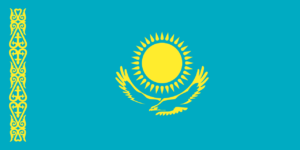Tribes that were nomadic initially called Kazakhstan home. The territory was conquered by the Mongol Empire in the thirteenth century and became a part of the Kazakh Khanate. Taraz and Turkestan were developed at this time as trading centers along the Great Silk Road. In the 1700s, as the Kazakh Khanate began to disintegrate, the Russian Empire started to conquer the region. The Kazakhs briefly enjoyed independence following the fall of the Russian Empire, but they quickly joined the Soviet Union. Nikita Khrushchev, the Soviet leader, launched the Virgin Lands program in 1953. This was an attempt to industrialize Kasakhstan’s agricultural-based economy.
When the Soviet Union fell in 1991, Kazakhstan gained independence. Since then, the nation has made significant progress toward establishing a market economy and has experienced rapid economic expansion.
| Capital | Astana |
| Population | 19,650,088 (Source: 2023 worldometer) |
| Major Cities | Almaty, Astana, Shymkent, Aktobe, Karaganda, Taraz, Semey, Pavlodar |
| Borders | Russia to the north and west, China to the east, Kyrgyzstan to the southeast, Uzbekistan to the south, and Turkmenistan to the southwest |
| Gross Domestic Product (GDP) | $220,623,000,000 (2022 worldometer) |
| Currency | tenge (KZT) |

Kazakhstan Major Industries: oil, coal, iron ore, manganese, chromite, lead, zinc, copper, titanium, bauxite, gold, silver, phosphates, sulfur, iron and steel; tractors and other agricultural machinery, electric motors, construction materials
Kazakhstan Agricultural Products: grain (mostly spring wheat), cotton; livestock
Kazakhstan Natural Resources: major deposits of petroleum, natural gas, coal, iron ore, manganese, chrome ore, nickel, cobalt, copper, molybdenum, lead, zinc, bauxite, gold, uranium
Kazakhstan Major Exports: oil and oil products 58%, ferrous metals 24%, chemicals 5%, machinery 3%, grain, wool, meat, coal (2001)
Kazakhstan Major Imports: machinery and equipment 41%, metal products 28%, foodstuffs 8% (2001)
Total Size of Kazakhstan: 331,690 km² (source: wikipedia)
Geographical Low Point of Kazakhstan: Vpadina Kaundy -132 m
Geographical High Point of Kazakhstan: Khan Tangiri Shyngy (Pik Khan-Tengri) 6,995 m
Climate of Kazakhstan: continental, cold winters and hot summers, arid and semiarid
General Terrain of Kazakhstan: extends from the Volga to the Altai Mountains and from the plains in western Siberia to oases and desert in Central Asia
World Region or Continent of Kazakhstan: Asia
Geographical Coordinates: 48 00 N, 68 00 E
Kazakhstan Government Type: republic; authoritarian presidential rule, with little power outside the executive branch
Kazakhstan Nationality: Kazakhstani(s)
Kazakhstan National Holiday: Independence Day, 16 December (1991)
Kazakhstan Independence: 16 December 1991 (from the Soviet Union)
Kazakhstan National Symbol: golden eagle
Kazakhstan National Anthem or Song: Menin Qazaqstanim (My Kazakhstan)
Kazakhstan Languages Spoken: Kazakh (Qazaq, state language) 64.4%, Russian (official, used in everyday business, designated the language of interethnic communication) 95% (2001 est.)
Kazakhstan Religions: Muslim 47%, Russian Orthodox 44%, Protestant 2%, other 7%
Kazakhstan is thought to be the home to over 120 different ethnic and national groupings.
The 7512 km border between Russia and Kazakhstan is the world’s longest continuous land border.
Ekibastuz GRES-2, a 420-meter-tall chimney in Kazakhstan, is the tallest chimney in the world.
The second-largest uranium reserves are found in Kazakhstan.
The ninth-largest nation in the world and the biggest without an ocean border is Kazakhstan.
The largest landlocked nation in the world is Kazakhstan.
The ninth-largest nation in the world is Kazakhstan.
The earliest domesticated horses were kept on the land that is now Kazakhstan.
Kazakhstan is home to the highest mountain ice rink in the world. On Kazakhstan’s mountain Medeo, 170 world records were established.
Kazakhstan is home to the largest and most established space launch site on earth. The first man (Yuri Gagarin) and artificial satellite (Sputnik 1) were launched into space at the Baikonur cosmodrome in Kazakhstan.
One of the biggest lakes in the world is Lake Balkhash. The lake is made up of salt water in the other half and fresh water in the other.
Astana, the name of Kazakhstan’s capital, is a translation of the word “capital city”.
The word “wanderer” is Kazakh. Kazakhstan literally translates as “Land of Wanderers.”
Despite Kazakhstan’s vast area, the country only possesses a small number of UNESCO sites.
Horse Milk is the national drink of Kazakhstan.
Since 1991, Kazakhstan has been free of the Soviet Union.
Time zone in Kazakhstan is UTC+05:00.
The largest city in Kazakhstan is Astana.
Kazakhstan has 99 of the elements listed in the Mendeleev Periodic Table.
The dish “Beshbarmak” is the most consumed food in Kazakhstan.
In Kazakhstan, horse meat is a staple of the cuisine.
In Kazakhstan, there are wild apple trees.
Snow leopards of a threatened species can be found in Kazakhstan.
Borat does not actually reside in Kazakhstan. First of all, he was expelled after Kazakhstan tourism was promoted using his tagline.
Russian and Kazakh are the two most widely used languages in Kazakhstan. They are very similar to one another.
There are 9 distinct characters in the Kazakh Cyrillic alphabet that are not included in the 33 characters of the Russian Cyrillic alphabet.
In Kazakh bars, clubs, and restaurants, beer is typically offered using a straw.

